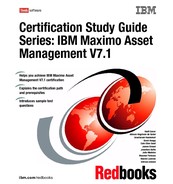58 Certification Study Guide Series: IBM Maximo Asset Management V7.1 Figure 4- 8 Inventory Costs dialog 4.3 Inventory applications This section describes each application included in this module. 4.3.1 Item Master The Item Master application is used to define items that will be stocked in your storerooms. When you create an item record, you define the possible attributes of the item, such as commodity codes, order and issue units, whether the item is lotted, rotating, or condition- enabled. With that, you also set any alternate items use in an item’s place and a list of the condition codes you want applied to the item. To access the application, select Go To . Inventory . Item Master. Item Master tabs The Item Master application has the following tabs. List Use this tab to search for item records. Although you may also use it to change status of multiple items, the tab has no other special action.
Chapter 4. Inventory 59 Item This tab is the main tab of the application. Use it to enter, view, or modify items. The two required fields for new items are: Item identifier and Lot Type ( although Lot Type is not required for rotating items). In this tab, you may also specify the main attributes for the items, such as commodity codes, meter, order and issue units, whether the item is rotating, kit, lotted or condition- enabled, and other attributes. Use the alternate sub tab to define items that can be used in place of other items. Use the Condition Codes sub tab to add condition codes that you want applied to the item. For more information, see 4.3.7, “ Condition Codes” on page 72. Note the following important concepts regarding the Item tab: – Rotating item A rotating item is a special category of item record, used to indicate items that can be used interchangeably as a replacement for a like item, such as fire extinguishers, motors, or pumps, but that are repaired or refurbished when they are removed from service. Rotating items can be managed like any other item record; they can be stocked in storerooms, issued and transferred, reordered and so forth. For example, if you have to create a maintenance schedule for a rotating item, you must create an asset record, mark it as rotating, and refer to the item. For more details about how rotating assets works, refer to Chapter 2, “ Assets” on page 11. – Item kit An item kit is a collection of items that can be issued as a single unit comprising of a parent item record and associated child item records. Item records contains a Kit? check box, which indicates that the item will act as the virtual container for all other items contained within the kit. Note: The alternate item relationship is not automatically reciprocated when you insert an alternate item to the current item record. If you want two items to be alternate to each other, each record should specify the other item as an alternate. Note: An item cannot be both a spare part and a rotating item because rotating items are maintained, and spare parts items are consumed or used once. Note: Item kits cannot be lotted, rotating, or condition- enabled.
60 Certification Study Guide Series: IBM Maximo Asset Management V7.1 Storerooms Use this tab to view a read- only list that has information about storerooms that stock the item. Examples are the costs and the balance for each storeroom. To add an item to a storeroom, select Select Action . Add items to Storeroom, as Figure 4- 9 shows. This action is accessible in all tabs of the Item Master application. Figure 4- 9 Add Items to Storeroom action Vendors Use this tab to enter, view, modify, or delete information about vendors and manufacturers for an item. The list can include vendors that you have previously ordered from, and vendors that you have not purchased the item from. You may use the vendor data to compare prices and delivery information. Specifications Use this tab to classify an item, and add, view, modify, or delete specifications that give details about the attributes of the item. Item Assembly Structure Use this tab to enter, view, or modify an item assembly structure ( IAS). An IAS is a list of individual items and subassemblies that are required when you build an asset or define the requirements of a location. Rather than specify item components each time you enter an individual asset or a location, you create an item assembly structure as a template. You may use an IAS as a template when building multiple asset assembly structures and their related location systems.
